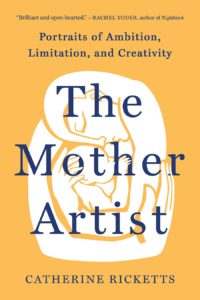In “The Mother Artist,” Author Catherine Ricketts Imagines A World Shaped By Care
Review by Kate Lewis
The central question in author Catherine Ricketts’ new work of non-fiction, The Mother Artist: Portraits of Ambition, Limitation, and Creativity, comes early on: “How might our world be humanized by work—art work, any work— made through a mother’s eyes?” (11) For Ricketts, the transformational experience of mothering – the tending to vulnerable bodies, the creation of communities, the constant giving of care – has the potential to shape not only art, but through art, it has the power to change the world.
Throughout The Mother Artist, Ricketts shows again and again how women pursuing creative lives seek this answer for themselves. Ricketts’ own experiences are woven alongside the work of writers like Leslie Jamison and Toni Morrison and artists like LaToya Hobbs and Aimee Koran. Each chapter traces a step in the making of mothers: pregnancy, labor, infancy, balance, ambition and beyond. The juxtaposition between each of the women and the way motherhood and art have shaped their lives illuminates how each common parenting moment is rendered specific to each artist, and the myriad possibilities for a world changed through caregiving and creativity.
A writer who has worked in the Philadelphia Museum of Arts and with other organizations dedicated to supporting creative endeavors, Ricketts brings a poetic and practical eye to her work. One of the most moving passages in the book is on the tedium of early motherhood, the emotional conflict between how infancy requires mothers to be hypervigilant and yet also feel as though nothing is being ‘done.’ In this time of close awareness, Ricketts envisions the ways this devotion to the care of others might be writ large unto society. “I imagine a city built through this [maternal]gaze: buildings designed, medicine practiced, public policy written, law enforced with eyes that are awed by the stranger,” she writes. “If we really saw each other, would our communities be marked by tenderness and not brutality?” (109)
For people who are in these early stages of combining the all-encompassing care of motherhood with their creative ambitions, Ricketts’ work is honest about the limitations (as the title implies) and yet also provides hope. Parenthood and creative expression can each enhance the other, instead of feeling like a fraught competition for time. Ricketts recounts in beautifully precise prose her own questions and conflicts in each stage of becoming a parent-artist, and in turning to the work of other mother-artists for inspiration, finds too some guidance on how to make it all sustainable. Abstract sculptor Senga Nengudi, whose innovative sculptures using nylon reflected her fascination with her pregnant body’s flexibility, paired up with the artist Maren Hassinger, to swap creative prompts. They would fill notebooks with daily creative inspiration, then mail them to one another for encouragement.
Visual artist Madeline Donahue also rises “to the occasions of her limitations,” according to Ricketts (183). She keeps her drawing materials close at hand during days with her children. When inspiration strikes, she turns her quick sketches into full paintings within a short span of time. “If I had two hours, it would be a two-hour painting,” Donahue says. “If I had ten hours, it would be a ten-hour painting” (183). She makes the most of the time she has with both her children and her art, and supplements her dedicated time for art with residencies. “She finds that if she has the opportunity to do a residency at least once a year, she can create a whole exhibition’s worth of pieces,” Ricketts writes. “She shows regularly at galleries in New York and Boston” (183).
As a writer who struggled both for time and creative inspiration during my children’s youngest years, the women Ricketts profiles are a beacon of possibility. Her final chapters – devoted to the tenets of community and perseverance – show precisely how caring for mothers in artistic spaces provides a blueprint for community transformation. Linda Goode Bryant’s 1974 opening of Just Above Midtown (JAM), a gallery founded to prioritize radical welcome and make space for the work of Black artists, made shared caregiving for children a structural priority. In its twelve years, JAM supported more than 600 artists. Possibilities abound when we shape our worlds around care, and artistic mothers are uniquely positioned to envision and enact the changes.
As Ricketts writes: “The more mothers persevere in making art, the more we draw out the best in one another, thus inviting our audiences to imagine and work for a world humanized by the love of a mother for herself, her family, and her communities” (188).
The Mother Artist by Catherine Ricketts
Broadleaf Books 2024
Hardcover, 210 Pages
ISBN 9781506488707
Kate Lewis’ writing has been nominated for Best of the Net and appears in The New York Times, The Washington Post, Good Housekeeping, Romper, Literary Mama, River Teeth’s Beautiful Things and elsewhere, and she also writes The Village on Substack. She lives along the tidewaters of Coastal Virginia with her husband, their two young children, and a mischief-making dog. Find her online @katehasthoughts.


